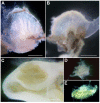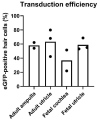Efficient Viral Transduction in Fetal and Adult Human Inner Ear Explants with AAV9-PHP.B Vectors
- PMID: 35740941
- PMCID: PMC9221426
- DOI: 10.3390/biom12060816
Efficient Viral Transduction in Fetal and Adult Human Inner Ear Explants with AAV9-PHP.B Vectors
Abstract
Numerous studies have shown the recovery of auditory function in mouse models of genetic hearing loss following AAV gene therapy, yet translation to the clinic has not yet been demonstrated. One limitation has been the lack of human inner ear cell lines or tissues for validating viral gene therapies. Cultured human inner ear tissue could help confirm viral tropism and efficacy for driving exogenous gene expression in targeted cell types, establish promoter efficacy and perhaps selectivity for targeted cells, confirm the expression of therapeutic constructs and the subcellular localization of therapeutic proteins, and address the potential cellular toxicity of vectors or exogenous constructs. To begin to address these questions, we developed an explant culture method using native human inner ear tissue excised at either fetal or adult stages. Inner ear sensory epithelia were cultured for four days and exposed to vectors encoding enhanced green fluorescent protein (eGFP). We focused on the synthetic AAV9-PHP.B capsid, which has been demonstrated to be efficient for driving eGFP expression in the sensory hair cells of mouse and non-human primate inner ears. We report that AAV9-PHP.B also drives eGFP expression in fetal cochlear hair cells and in fetal and adult vestibular hair cells in explants of human inner ear sensory epithelia, which suggests that both the experimental paradigm and the viral capsid may be valuable for translation to clinical application.
Keywords: AAV; AAV9-PHP.B; ampulla; cochlea; gene therapy; hair cell; hearing loss; inner ear; saccule; utricle; vestibular.
Conflict of interest statement
J.R.H. holds a patent on the use of AAV9-PHP.B for gene delivery to the inner ear and is an advisor to several biotech companies focused on inner ear therapeutics. The authors declare no other conflicts of interest. The funders had no role in the design of the study; in the collection, analyses, or interpretation of data; in the writing of the manuscript; or in the decision to publish the results.
Figures







Similar articles
-
Optimized AAV Vectors for TMC1 Gene Therapy in a Humanized Mouse Model of DFNB7/11.Biomolecules. 2022 Jun 29;12(7):914. doi: 10.3390/biom12070914. Biomolecules. 2022. PMID: 35883470 Free PMC article.
-
Efficient viral transduction in mouse inner ear hair cells with utricle injection and AAV9-PHP.B.Hear Res. 2020 Sep 1;394:107882. doi: 10.1016/j.heares.2020.107882. Epub 2020 Jan 13. Hear Res. 2020. PMID: 31980281
-
Single and Dual Vector Gene Therapy with AAV9-PHP.B Rescues Hearing in Tmc1 Mutant Mice.Mol Ther. 2021 Mar 3;29(3):973-988. doi: 10.1016/j.ymthe.2020.11.016. Epub 2020 Nov 17. Mol Ther. 2021. PMID: 33212302 Free PMC article.
-
Mammalian auditory hair cell regeneration/repair and protection: a review and future directions.Ear Nose Throat J. 1998 Apr;77(4):276, 280, 282-5. Ear Nose Throat J. 1998. PMID: 9581394 Review.
-
Emerging Gene Therapies for Genetic Hearing Loss.J Assoc Res Otolaryngol. 2017 Oct;18(5):649-670. doi: 10.1007/s10162-017-0634-8. Epub 2017 Aug 16. J Assoc Res Otolaryngol. 2017. PMID: 28815315 Free PMC article. Review.
Cited by
-
Light at the end of the tunnel of Corti.Mol Ther Methods Clin Dev. 2023 May 23;29:437-438. doi: 10.1016/j.omtm.2023.05.006. eCollection 2023 Jun 8. Mol Ther Methods Clin Dev. 2023. PMID: 37273898 Free PMC article. No abstract available.
-
Engineering of the AAV-Compatible Hair Cell-Specific Small-Size Myo15 Promoter for Gene Therapy in the Inner Ear.Research (Wash D C). 2024 Apr 25;7:0341. doi: 10.34133/research.0341. eCollection 2024. Research (Wash D C). 2024. PMID: 38665848 Free PMC article.
-
AAV-mediated Gene Therapy for Hereditary Deafness: Progress and Perspectives.Adv Sci (Weinh). 2024 Dec;11(47):e2402166. doi: 10.1002/advs.202402166. Epub 2024 Nov 18. Adv Sci (Weinh). 2024. PMID: 39556694 Free PMC article. Review.
-
Systemic administration of novel engineered AAV capsids facilitates enhanced transgene expression in the macaque CNS.Med. 2023 Jan 13;4(1):31-50.e8. doi: 10.1016/j.medj.2022.11.002. Epub 2022 Nov 22. Med. 2023. PMID: 36417917 Free PMC article.
-
Optimized AAV Vectors for TMC1 Gene Therapy in a Humanized Mouse Model of DFNB7/11.Biomolecules. 2022 Jun 29;12(7):914. doi: 10.3390/biom12070914. Biomolecules. 2022. PMID: 35883470 Free PMC article.
References
Publication types
MeSH terms
Grants and funding
LinkOut - more resources
Full Text Sources

